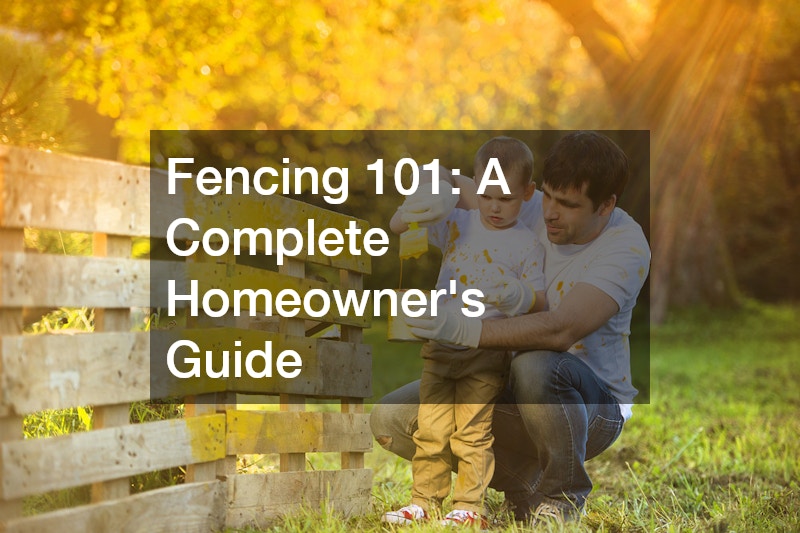A well-chosen fence can transform your property, enhancing its beauty, privacy, and safety. However, selecting the right fence for your home can feel overwhelming. With so many materials, styles, and installation options, it’s easy to become unsure of where to start. This guide is designed to simplify the process, offering homeowners an in-depth look at fencing basics, material options, maintenance considerations, and expert tips for choosing the best solution for your property.
Understanding the Purpose of Your Fence
Before selecting a fence, it’s crucial to determine its primary purpose. Fences serve multiple functions, and understanding your priorities will guide your decisions.
For some homeowners, privacy is the main concern. Fences can create a secluded backyard, blocking the view from neighbors or passersby. Popular privacy options include tall wooden panels, vinyl privacy fences, and composite fences.
Safety and security are also common priorities. If you have children or pets, a fence can keep them safe and prevent them from wandering into the street. For security, homeowners often choose strong materials like wrought iron, chain-link, or high-quality vinyl.
Aesthetic appeal is another important consideration. Fences can accentuate your landscaping, complement your home’s architecture, and even increase curb appeal. Decorative fences such as picket, ornamental iron, or lattice-top designs add visual interest without compromising function.
Choosing the Right Fence Material
Fences come in a variety of materials, each with distinct benefits and considerations. Understanding the pros and cons of each will help you make a decision that suits your budget, maintenance expectations, and desired style.
Wood Fences:
Wood remains a popular choice for homeowners due to its natural appearance and versatility. You can paint or stain wood fences to match your home’s color palette. Common types of wood include cedar, pine, and redwood. While wood provides excellent privacy and aesthetic appeal, it requires regular maintenance, such as sealing, staining, or painting, to prevent rot, warping, and insect damage.
Vinyl Fences:
Vinyl fences are highly durable and virtually maintenance-free. They resist rotting, fading, and insect damage, making them an excellent long-term investment. Vinyl comes in a range of colors and styles, including privacy panels and picket designs. The main consideration is cost, as vinyl fences tend to have a higher upfront price compared to wood.
Aluminum and Wrought Iron Fences:
These fences offer strength, longevity, and a classic appearance. Aluminum fences are lightweight, rust-resistant, and require minimal maintenance, while wrought iron fences provide maximum security and elegance but may require periodic painting to prevent rust. Both are ideal for decorative purposes and for securing a property without obstructing views.
Chain-Link Fences:
Chain-link fencing is a cost-effective option for security, especially for larger properties or commercial areas. While they don’t provide much privacy, adding privacy slats can help. Chain-link fences are low maintenance, durable, and easy to install.
Composite Fences:
Composite fencing combines wood fibers and recycled plastic, offering the look of wood with the durability of vinyl. These fences are resistant to rot, insects, and weather damage. They typically require less maintenance than wood and can last for decades.
Understanding Fence Heights and Local Regulations
Fence height often depends on its purpose and local regulations. Most residential fences range from three to eight feet tall. Privacy fences typically start at six feet, while decorative or boundary fences may be shorter.
Before installing any fence, check local zoning laws, homeowners association rules, and permit requirements. Some areas have restrictions on fence height, placement, and materials. Understanding these rules can prevent costly fines or the need to modify your fence after installation.
Installation Considerations
Fence installation can be a DIY project, but many homeowners choose professional installation to ensure a long-lasting, secure result.
Proper installation includes preparing the ground, digging posts to the correct depth, and ensuring the fence is level and straight. Incorrect installation can lead to leaning panels, uneven gates, or reduced lifespan. Professional fencing companies have the tools and expertise to complete the job efficiently, often offering warranties for peace of mind.
Gates are an important aspect of any fence. Consider the type, placement, and security features. A well-installed gate not only provides access but also contributes to the overall functionality and appearance of your fence.
Maintenance Tips for Longevity
The lifespan of a fence depends on the material, environmental conditions, and maintenance. Regular care can extend the life of your investment.
For wood fences, inspect for rot, insect damage, and loose boards. Cleaning the surface and applying sealant or stain every few years can protect it from weathering. Vinyl fences require minimal maintenance, but occasional cleaning with soap and water keeps them looking new. Aluminum and wrought iron fences benefit from annual inspections and rust prevention treatments, while chain-link fences should be checked for damage or sagging over time.
Landscaping also impacts fence durability. Avoid planting trees or shrubs too close to the fence line, as roots can disrupt posts and branches can cause damage during storms.
Cost Considerations
Fence costs vary widely based on material, height, length, and installation method. Wood fences are typically mid-range, vinyl and composite fences have a higher upfront cost but lower maintenance, and chain-link fences are often the most affordable.
It’s essential to consider long-term expenses alongside the initial investment. A durable, low-maintenance fence may cost more upfront but save money over time compared to cheaper materials that require frequent repairs or replacement.
Enhancing Your Fence with Style and Function
Fences don’t just define your property—they can enhance its functionality and appearance. Adding decorative elements like lattice panels, finials, or lighting can improve curb appeal. For homeowners with children or pets, consider features like secure gates, rounded edges, or built-in barriers to ensure safety.
Fences can also serve as a foundation for landscaping. Climbing plants, trellises, or hedges can soften the look of a fence, creating a natural, integrated appearance.
A well-planned fence can dramatically improve your home’s appearance, privacy, and security. Understanding the different materials, styles, heights, and maintenance requirements helps homeowners make informed decisions that fit their lifestyle and budget. Whether you choose a classic wooden fence, a durable vinyl option, or a decorative aluminum design, investing in the right fence enhances both the beauty and functionality of your property. For expert guidance and professional installation, partnering with a trusted fencing company ensures your investment is built to last, providing peace of mind and long-term satisfaction.



